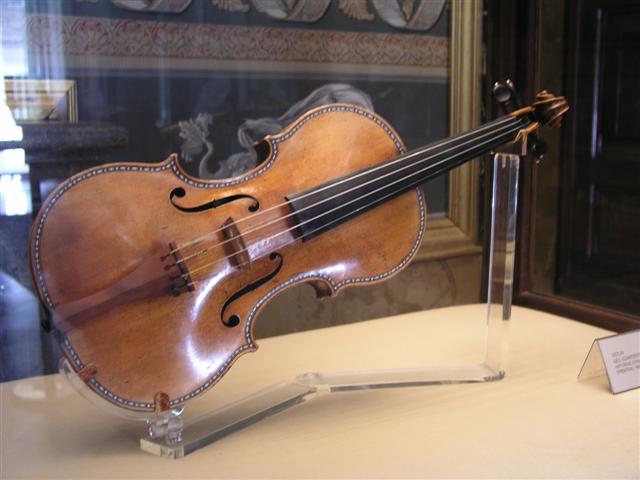STRAD (strad)
A
violin made by the Italian luthier, Antonio Stradivari
Common
clue: Fine fiddle; Valuable violin, for short; Cremona
collectible; Priceless instrument; Precious strings; Dear
fiddle
Crossword
puzzle frequency:
once a year
News: Border
guards prevent attempt to illegally take out 1713 Stradivarius
violin from Ukraine - Border Guard Service
Video:
Stradivarius
Secret Found By Texas Chemist
Antonio Stradivari (1644? - December 18, 1737) was an Italian luthier (maker of violins and other stringed instruments), the most prominent member of that profession. The Latin form of his surname, "Stradivarius" - sometimes shortened to "Strad" - is often used to refer to his instruments.

Antonio
Stradivari was born in the year 1644 (by some sources also in 1649
or 1650) in Cremona, Italy to Alessandro Stradivari and Anna
Moroni. Probably in the years 1667 through 1679 he served as a
pupil in Amati's workshop.
In 1680 Stradivari set up for himself in the Piazza San Domenico, and his fame as a instrument-maker was soon established. He now began to show his originality, and to make alterations in Amati's model. The arching was improved, the various degrees of thickness in the wood were more exactly determined, the formation of the scroll altered, and the varnish more highly coloured. His instruments are recognized by their inscription in Latin: Antonius Stradivarius Cremonensis Faciebat Anno [date] (Antonio Stradivari, Cremona, made in the year ...). It is generally acknowledged that his finest instruments were manufactured from 1698 to 1725 (peaking around 1715), exceeding in quality those manufactured between 1725 and 1730. After 1730, some of the instruments are signed sub disciplina Stradivarii, and were probably made by his sons, Omobono and Francesco.
Apart from violins, Stradivari also made harps, guitars, violas, and cellos — more than 1,100 instruments in all, by current estimate. About 650 of these instruments survive today. Antonio Stradivari died in Cremona, Italy on December 18, 1737 and is buried in the Basilica of San Domenico in Cremona.
His instruments are regarded as amongst the finest stringed instruments ever created, are highly prized, and still played by professionals today. Only one other maker, Joseph Guarneri del Gesu, commands the same respect among violin soloists.
A Stradivarius made in the 1680s, or during Stradivari's "Long Pattern" period from 1690 to 1700, could be worth hundreds of thousands to several million U.S. dollars at today's prices. The 1697 "Molitor" Stradivarius, once rumored to have belonged to Napoleon (it actually belonged to a general in his army, Marshal Gabriel Jean Joseph Molitor, 1er Comte Molitor), sold in 2010 at Tarisio Auctions to violinist Anne Akiko Meyers for $3,600,000, at the time a world record.

Depending
on condition, instruments made during Stradivari's "golden
period" from 1700 to about 1725 can be worth millions of
dollars. In 2011, his "Lady Blunt" violin from 1721,
which is in pristine condition, was sold in London for $15.9
million (it is named after Lord Byron's granddaughter Lady Anne
Blunt, who owned it for 30 years). It was sold by the Nippon Music
Foundation in aid of the Japanese earthquake and tsunami appeal.
In Spring 2014 the "Macdonald" viola was put up for
auction through the musical instrument auction house Ingles &
Hayday in conjunction with Sotheby's via silent auction with a
minimum bid of $45 million. The auction failed to reach its
minimum bid by 25 June 2014, and the viola was not sold.
Other famous Stradivarius instruments are the Davidov Strad, a cello currently owned and played by Yo-Yo Ma, and the Duport Strad cello owned by Mstislav Rostropovich. The Soil Strad of 1714 is owned by virtuoso Itzhak Perlman, and many consider it among the finest of all Strads.
The world's two largest publicly-accessible collections of Stradivari instruments belong to the King of Spain, consisting of two violins, two cellos, and a viola, exhibited in the Music Museum at the former Royal Palace (Palacio Real) in Madrid, and the U.S Library of Congress' collection of three violins, a viola, and a cello.
This article is licensed under the GNU Free Documentation License. It uses material from the Wikipedia article "Antonio Stradivari".
TET (401)
NA
|
|